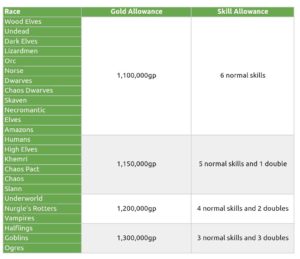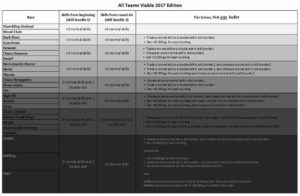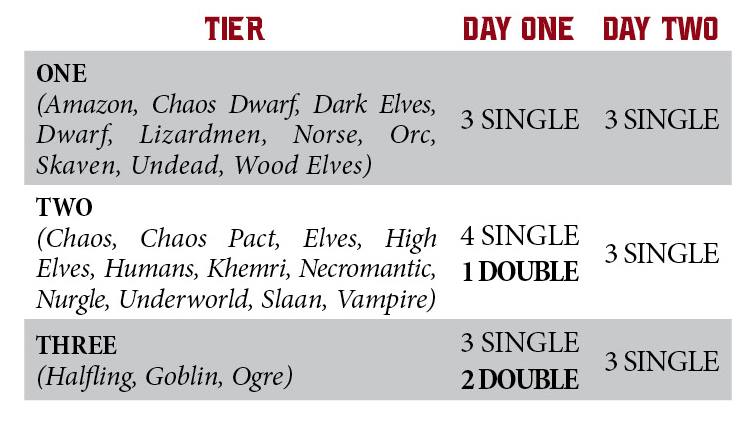The term “Tiers” in Blood Bowl is used to refer to the different winning abilities of the different races in Blood Bowl. In the original 3rd Edition rules, there was the Designer’s Note that said there are some races that are more challenging, and since then this has been more finely tuned as the performance of the different races has been observed and measured.
There is debate over how many tiers there should be, and where teams should fall for a particular ruleset, but this is an example to give you a flavour of where the teams fall:
Tier 1: Chaos Dwarf, Dwarf, Wood Elves, Skaven, Norse, Lizardmen, Orc, Undead, Amazon, Dark Elves
Tier 2: Chaos, Human, Khemri, Pact, Slann, High Elves, Nurgle, Necromantic, Pro Elves, Vampires, Underworld
Tier 3: Halflings, Goblins, Ogres (collectively known as the “stunty” teams, who often get awarded a special “stunty cup” for the highest placed in a tournament)
These tiers reflect the fact that that the majority of tournaments were won by the teams in Tier 1, with more occasional wins from Tier 2, and rare tournament wins by stunty teams. As well as tournament wins, there has also been statistical analysis done of the overall win percentage, with draws counting as half a win. During the time of the BBRC the following win percentages were used in choosing which teams to tweak, making them more or less powerful, and this was largely guided towards league play, so the tiers were somewhat different.
Tier 1 – 55% to 45% win rate : Any team not in another Tier
Tier 1.5 – 50% to 40%: Chaos Pact, Slann and Underworld
Tier 2 – 45% to 35% : Vampire
Tier 3 – 35% to 30%: Halfling, Goblin, Ogre
So how do these Tiers affect the game? In league play, usually not at all – the majority of leagues ignore them, and leave the lower Tier teams as challenges for more experienced coaches or those who don’t mind about winning (though there are notable exceptions, such as those leagues that use Narrow-Tier Blood Bowl (NTBB), which changes the stats and the costs of the various races). But in Tournaments and one-off games, since 2010 there have often been allowances made to weaker teams to give them more of a chance of competing. The remainder of this article will talk about Tournaments, but basically if you ever play a one-off game one good option is to choose a set of Tournament rules and build teams based on those rules.
Before talking about Tiering however, it’s worth a recap of Tournament rules in general, and I’ve written about those in more depth here. In short, instead of having 1,000,000 gps to build (100TV), you have more (e.g. 1,100,000, or 110TV), and instead of having to earn skill using SPPs, you get allocated skills, either all at the beginning or at various stages throughout the tournament. This allows for flexibility in how much money or how many skills, as well as which inducements they are allowed (in addition to Goblins getting cheaper bribes and Halflings a cheaper chef, as per the rulebook).
On to Tiering then, with some examples. Let’s start with the NAF Championship, the biggest individual BB tournament. For a long time there was no Tiering, to make it accessible to new coaches, but for the first time in 2017 the NAFC put the following into place. All teams had 110TV, and then received skills at the start of day 1 and the start of day 2.
So far, so good. This tournament was won by Dark Elves, but there were also Halfings in 12th and Necromantic in the final. Similarly, the Eurobowl had a Necromantic team as its best performing team, with the following rules:
All skills chosen before the tournament, 1,100,000 gps, plus extra money for Tier 2 and Tier 3 teams, which can be used for players, goods or skills (20k normal, 30k double).
- Tier 1: 6 normal skills
- Tier 2: 6 normal, 1 double, 20k cash
- Tier 3: 6 normal, 2 double, 50k cash
You can then go to more Tiers, and the Danish Open and Capital Shield (NZ) have gone for a more detailed breakdown (click to make larger):


There is then an alternative approach, which focuses on the skills themselves as well as the teams, and one of the more intricate implementations of this is the “Ironmanj” ruleset, which is now used in the Spike! Trophy in Canada, which is one of the NAF Majors. It’s a bit complicated, but here we go!
Coaches may spend up to 1,200,000 gc on their teams. Coaches may not include Star Players as part of their team unless they have the Secret Weapon or Stab skills (except Zara – she is not allowed). An exception to this rule are Halfling, Goblin, Ogre and Underworld teams, who may hire up to two Star Players as normal.
You may purchase any other Inducements except Wizards, Mercenaries or Special Play Cards as a permanent part of your team for their normal cost.
Skills
Tier 1 skill = Block, Frenzy, Kick, Strip Ball, Sure Hands, Dodge, Leader, Guard, Mighty Blow and Claw.
Tier 2 skill = anything else.
1 point for the first instance of a Normal tier 2 skill.
2 points for any other instance of a Normal tier 2 skill.
2 points for the first instance of a Normal tier 1 skill.
3 points for any other instance of a Normal tier 1 skill.
+2 points if that skill is from a ‘Doubles’ category.
No player may have more than one extra skill. Star Players may not be given extra skills.
Teams have the following points to spend:
9 points – Undead, Wood Elf, Amazon, Chaos Dwarf, Lizardmen
11 points – Dwarf, Orc, Norse, Dark Elf, Skaven
13 points – High Elves, Humans, Pro Elves, Necromantic, Khemri
15 points – Slann, Underworld, Chaos Pact, Nurgle, Chaos, Vampires
17 points – Goblin, Halfling, Ogre
So there we have it – there are are dozens of possibilities, and you can browse the different rulesets right here, and come up with your own for TheoryBowl, a one-off game, or even run a tournament yourself.

What about old world?
This is an older 2017 post and would have to be updated with current teams and performance.
E.g. as found here: https://member.thenaf.net/index.php?module=NAF&type=statistics